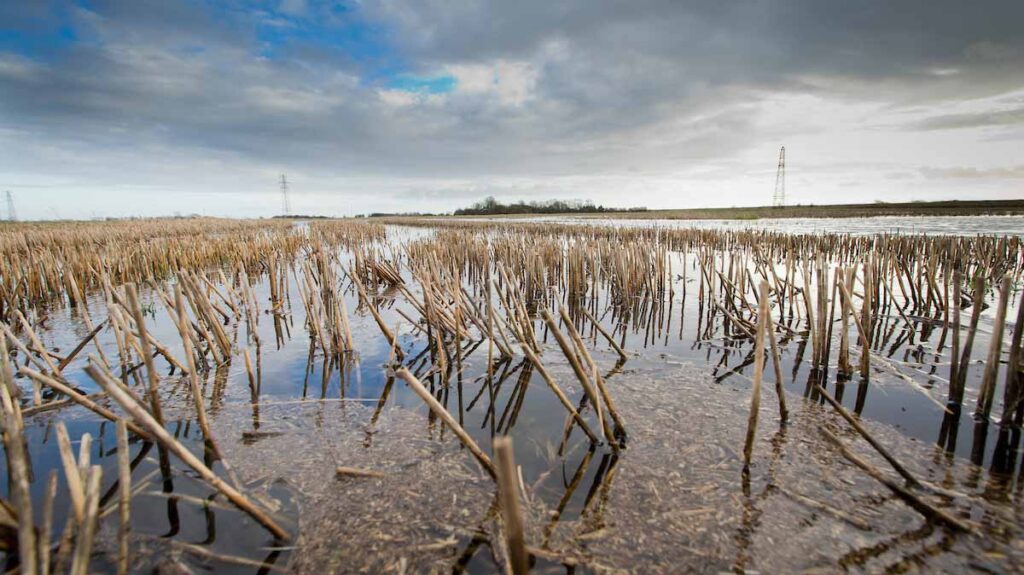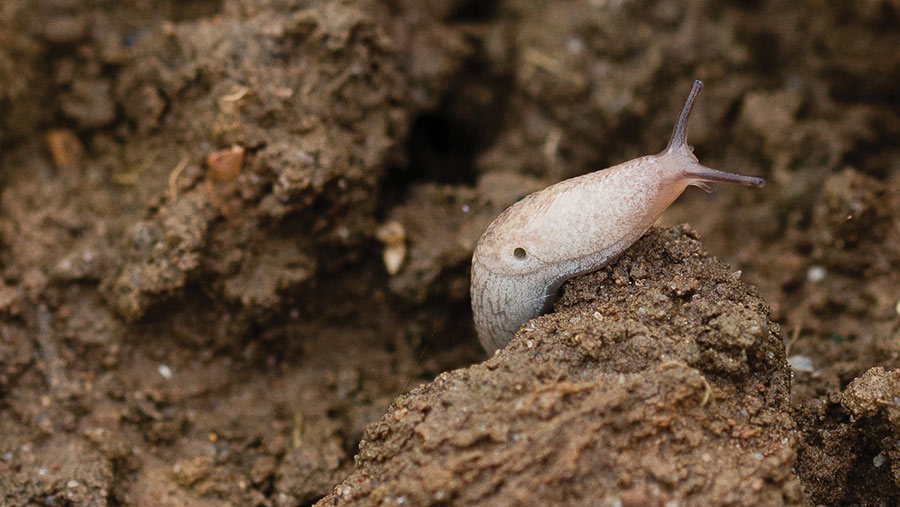Crop Watch: Wheat crop failures and missed herbicides
 © Gary Naylor Photography
© Gary Naylor Photography The huge cost of week after week of rain is becoming apparent, with wheat crops rotting and being written off.
Many of those crops that have survived have not received their planned herbicide programmes, or any insecticides for barley yellow dwarf virus (BYDV).
In OSR, there is a greater reliance on propyzamide for blackgrass control, as the cut-off for clethodim passed while sprayers were stranded in the shed. One thing that is becoming clearer is that the spring cropping area is going to be greater than originally planned for.
See also: Crop Watch: Wet autumn sees rotting seed and missed sprays
North: David Martindale
Arable Alliance (Yorkshire)
The past month has been extremely difficult due to frequent deluges, which have seriously affected cereal establishment and prevented application of herbicides for grassweed control.
A small drilling window in mid-October saw a flurry of winter wheat crops sown, only for them to be sat in waterlogged or saturated soils for the next month.
Emergence of these crops has been patchy, especially on heavier soils, where in some cases whole fields have already been written off due to waterlogging.
On the marginal fields, decisions will soon be made about which areas to keep, and which will be redrilled in the spring.
Another issue is where wheat establishment is acceptable, but no herbicides for blackgrass or ryegrass control have been applied.
In fields with high infestations of these weeds, starting again in the spring with a new cereal crop may still be the best option. September-sown winter wheat crops generally look well.
The application of pre-emergence and/or peri-emergence herbicides for grassweed control has been limited due to poor weather.
There can only be about 5% of crops that have established well and received both their pre- and peri-emergence herbicides on time.
Where only a pre-emergence herbicide mix has been applied, blackgrass and ryegrass control has generally been good.
The plentiful supply of soil moisture has allowed these active ingredients to achieve their best efficacy.
Oilseed rape
Slugs are still causing lots of problems on later sown crops, with repeated applications of slug pellets struggling to provide sufficient control to allow good crop establishment.
Volunteer beans in winter wheat crops will require controlling with a contact-acting herbicide as soon as conditions allow, and manganese applications are needed on earlier sown crops on lighter soils.
Although cabbage stem flea beetle numbers have declined in recent weeks, so too has the area of viable oilseed rape.
This is due to
saturated soils and continued high slug pressure, making some marginal crops a failure.
The oilseed rape area has been maintained to some extent due to many of the redrilled crops establishing well and now having four to six true leaves.
Unfortunately, a lot of the planned clethodim applications for blackgrass control in oilseed rape have not been made before the cut-off date of 31 October.
Therefore, it only leaves propyzamide to provide any grassweed control, with history and experience showing that control can be variable.
This could lead to high numbers of blackgrass surviving in the oilseed rape crops, which might not be too obvious to see.
However, a large seed return may be the hidden consequence in the following winter wheat.
Phoma leaf spot in oilseed rape has often exceeded threshold levels, so a fungicide is being applied for its control.
Pigeons have begun landing in oilseed rape fields already, and keeping them off crops is going to be challenging, especially where OSR plants are small.
West: Neil Potts
Matford Arable (Devon)
With just over 25cm of recorded rain since my last entry, the main thrust of this report is to say that there is nothing to report.
I am not aware of a single field having been drilled since I last contributed, and very few fields have had any barley yellow dwarf virus material or post-emergence herbicide applied.
I keep hearing how there is a lot of slug damage out there at present, but I have to say I am seeing very little in the way of slug activity.
There are missing patches in crops, but these are purely down to waterlogging, not slug activity.
Where blackgrass is an issue in oilseed rape, we are seeing the blackgrass growing well, with the window for products such as Centurion Max (clethodim) now missed.
There is going to be a very heavy reliance on propyzamide to work well in order for us to get any level of control.
Residual herbicides
Pre-emergence applications in cereal crops appear to be working well despite the challenging weather. Certainly, the lack of soil moisture cannot be blamed for poor performance of residuals.
If anything, the polar opposite will be the case this autumn. With a lot of wheat left to be planted, I would urge growers to try to get the crop in the ground, even if the timing and the conditions are suboptimal.
The reason for this advice is that there is just not going to be enough spring cereal seed available to allow people to substitute planned winter cereal plantings with spring ones. In short, 2023 just keeps on giving.
I, for one, will be heartily glad to see the back of this extremely challenging year.
I would like to wish anyone with winter crops still to be planted the very best of luck. It is going to be needed, along with a prolonged and, therefore, unseasonable dry spell.
South: Tod Hunnisett
AICC (Sussex)
In my last Crop Watch article published a month ago, everything looking pretty positive.
Unfortunately, since then we’ve been working our way through the alphabet in storms, and not a lot has happened out in the fields.
Violent rain has resulted in significant proportions of some fields ending up in the road, or even worse, in the river, along with the inevitable doses of phosphate and pre-emergence active ingredients.
To some extent, the rainy conditions have helped to make decision-making easier, because even if you identify problems, there is no point trying to rectify them until the weather settles down.
There are outstanding recommendations on farm for follow-up herbicides and aphicides, many of which are still valid, with little or no tweaking.
Aphid count numbers are falling (I don’t half miss Syngenta’s system), but aphids in the crop could still pose a threat if the winter or early spring becomes mild – remember 2016?
I’m struggling to find any aphids in crops at the moment, but others tell me they are about. Those finding them must have very dirty knees.
Crop effects
Many actives in pre-emergence sprays have shown crop effects this year. Some are quite dramatic.
On the whole, I’m not too worried about it. Very rarely does it manifest as a yield reduction, and it usually signifies a successful kill on the target weeds.
The weather patterns we’ve experienced over the past few years seem to show long spells of one type, followed by long spells of the opposite.
Getting stuff done during the spells of permissible weather is becoming more and more important.
There’s every chance a settled spell will arrive before Christmas that will allow us to catch up.
I think we’ve had one year in the past 10 when we’ve been able to frost-proof the sprayer, and put it away in the shed for the winter.
I know some agronomists who would prefer it if the operators had full-time living accommodation installed in their sprayer and tractor cabs.
East: Ben Pledger
Farmacy (Bedfordshire/Hertfordshire)
They say every cloud has a silver lining. Unfortunately, the clouds only seem to deliver rain. However, in this area I think we’ve got away lighter than other places.
I flew into Gatwick at the start of the month, and Kent looks much wetter than it was locally when I got home to Hertfordshire.
I then drove to Lincolnshire, which was a similar story. A fair amount of cereals have been drilled in the area, with varied success of establishment. Earlier drilled wheats and barleys look well.
But on heavier land, where drilling was delayed for blackgrass, establishment hasn’t been as good, especially on headlands where compaction issues are coming to light.
Even fields that haven’t been rolled or had a pre-emergence herbicide applied are showing damage.
This is down to overworking during cultivation, which has destructured the soil, as well as overtrafficking on turning headlands, causing compaction.
This is now holding water in the profile where the seed is sitting, and allowing it to rot away.
Slugs are also an issue, especially in cereals following oilseed rape.
Ferric phosphate slug pellets have been applied where traps contained slugs, and usually with good effect from just one dose.
However, slug populations in some fields are high. Persistent doses of more than one pellet have been needed in these situations.

© Blackthorn Arable
Wet land
In a lot of places, it is too wet to even drive a quad bike across the land, so the ability to get on with a sprayer to apply post-emergence residual herbicides or barley yellow dwarf virus insecticides is limited.
With the weather mild and aphids present, there is still the need to control them.
However, the physical practicality of doing this is another story.
With growers now looking for any opportunity to apply these pesticides, thought must be given to the environmental effect some applications will invariably have.
On top of this, chemistry applied to water-stressed crops will only increase the pressure they are under.

